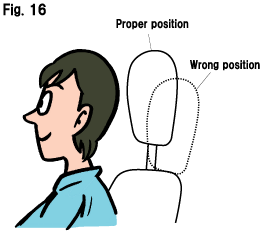 Introduction Introduction |
While the number of traffic accident fatalities has been on the decline in recent years, that of injuries has been rising. A significant percentage of this increase is due to the surge of people injured by rear-end collisions.
A driver/passenger of a vehicle struck from behind often sustains a minor cervical injury, which is more commonly known as whiplash. How can we protect ourselves from such injuries?
This issue of ITARDA INFORMATION takes a look at head restraints, which are installed precisely for that purpose, and how to adjust them properly.
|
|
 Conclusion Conclusion
|
Rear-end crashes, which account for one-third of all traffic accidents, often cause whiplash injuries in the driver/passenger of the car hit from the rear. The analysis of traffic accident data in Japan clearly shows that a properly positioned head restraint effectively prevents this type of injury.
The proper position of a head restraint is:
- High enough so that the head will not tilt over the restraint
- Forward and as close to the back of the head as possible
A headrest, as it is called in Japanese, is not a head pillow for comfort, but a safety device that protects the vehicle occupant in the event of a rear-end collision. Remember this. If your car has an adjustable head restraint, adjust it immediately to fit your height!
|
|

|
Information in this issue is a roundup of ITARDA's past studies(4)(5). Check the originals listed below for details
|
|
Institute for Traffic Accident Research and Data Analysis (ITARDA)
|
|




